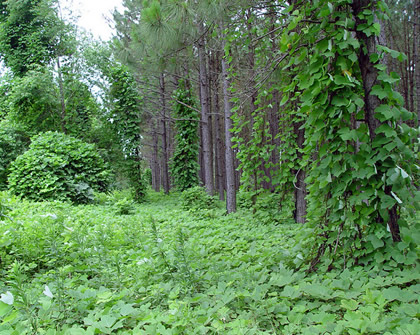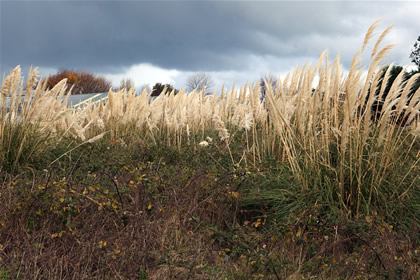Agriculture
Biological invasions are the entry of a type of organism into an ecosystem outside its historic range. In a biological invasion, the "invading" organism may be an infectious virus, a bacterium, a plant, an insect, or an animal.
Species introduced to an area from somewhere else are referred to as alien or exotic species or as invaders. Because an exotic species is not native to the new area, it is often unsuccessful in establishing a viable population and disappears.
The fossil record, as well as historical documentation, indicates that this is the fate of many species in new environments as they move from their native habitats. Occasionally, however, an invading species finds the new environment to its liking.
In this case, the invader may become so successful in exploiting its new habitat that it can completely alter the ecological balance of an ecosystem, decreasing biodiversity and altering the local biological hierarchy. Because of this ability to alter ecosystems, exotic invaders are considered major agents in driving native species to extinction.
Biological invasions by notorious species constitute a significant component of earth?s history. In general, large-scale climatic changes and geological crises are at the origin of massive exchanges of flora and fauna. On a geologic time scale, migrations of invading species from one continent to another are true evolutionary processes, just as speciation and extinction are.
On a smaller scale, physical barriers such as oceans, mountains, and deserts can be overcome by many organisms as their populations expand. Organisms can be carried by water in rivers or ocean currents, transported by wind, or carried by other species as they migrate seasonally or to escape environmental pressures.
Humans have transplanted plants since the beginning of plant cultivation in pre-Columbian times. The geological and historical records of the earth suggest that biological invasions contribute substantially to an increase in the rate of extinction within ecosystems.
Invasive Plants
In modern times, most people are not aware of the distinction between native plants and exotic species growing in their region. Recent increases in intercontinental invasion rates by exotic species, brought about primarily by human activity, create important ecological problems for the recipient lands. Invasive plants in North America include eucalyptus trees, morning glory, and pampas grass.
It would seem logical to assume that invading species might add to the biodiversity of a region, but many invaders have the opposite effect. In all ecosystems the new species are often opportunistic, driving out native species by competing with them for resources.
For example, Pueraria lobata, or kudzu, is a vine native to Japan. Introduced in the United States at the 1876 Philadelphia Exposition, kudzu was planted to control erosion on hillsides and for livestock forage. By the end of the twentieth century, it could be found from Connecticut to Missouri, extending south to Texas and Florida.
 Kudzu covers everything in its path and grows as much as 1 foot (0.3 meter) per day. Similarly, English ivy (Hedera helix), a native of Eurasia, is considered a serious problem in West Coast states. It forms "ivy deserts" in forests and crowds out native trees and shrubs that make up essential wildlife habitat.
Kudzu covers everything in its path and grows as much as 1 foot (0.3 meter) per day. Similarly, English ivy (Hedera helix), a native of Eurasia, is considered a serious problem in West Coast states. It forms "ivy deserts" in forests and crowds out native trees and shrubs that make up essential wildlife habitat.
The invasion of an ecosystem by an exotic species can effectively alter ecosystem processes. An invading species does not simply consume or compete with native species but can actually change the rules of existence within the ecosystem by altering processes such as primary productivity, decomposition, hydrology, geomorphology, nutrient cycling, and natural disturbance regimes.
Invasive Insects and Microorganisms
The invasion of native forests alone by nonnative insects and microorganisms has been devastating on many continents. The white pine blister rust and the balsam woolly adelgid have invaded both commercial and preserved forest lands in North America. Both exotics were brought to North America in the late 1800?s on nursery stock from Europe.
The balsam woolly adelgid attacks fir trees and causes their death within two to seven years from chemical damage and by feeding on the trees? vascular tissue. The adelgid has killed nearly every adult conebearing fir tree in the southern Appalachian Mountains.
The white pine blister rust attacks five-needle pines; in the western United States fewer than 10 pine trees in 100,000 are resistant. Because white pine seeds are an essential food source for bears and other animals, the loss of the trees is having severe consequences across the food chain.
Since the 1800?s the deciduous trees of eastern North America have been attacked numerous times by waves of invading exotic species and diseases. One of the most notable invaders is the gypsy moth, which consumes a variety of tree species. Other invaders have virtually eliminated the once-dominant American chestnut and the American elm.
 Tree species that continue to decline because of new invaders include the American beech, mountain ash, white birch, butternut, sugar maple, flowering dogwood, and eastern hemlock. It is widely accepted that the invasion of exotic species is the single greatest threat to the diversity of deciduous forests in North America.
Tree species that continue to decline because of new invaders include the American beech, mountain ash, white birch, butternut, sugar maple, flowering dogwood, and eastern hemlock. It is widely accepted that the invasion of exotic species is the single greatest threat to the diversity of deciduous forests in North America.
Effects on Humans and Humans as Invaders
Some introduced exotic species are beneficial to humanity. It would be impossible to support the present world human population entirely on species native to their regions. Humans, the ultimate biological invaders, have been responsible for the extinction of many species and will continue to be in the future.
At the beginning of the twenty-first century, the United States was spending $4 billion annually to eradicate invasive plant species, a figure that does not take into account loss of biodiversity or wildlife habitat.
- Caribbean Flora
Caribbean FloraThe Caribbean region is noted for its diverse and varied vegetation. Flowers thrive in the moist, tropical environment found on many islands. Hibiscus, bougainvillea, and orchids are just a few of the varieties found there. The heavily...
- Clines
ClinesA cline is one form of geographic variation in which characteristics of a species change gradually through the species? geographic range. Many plant and animal species have populations that differ in terms of their morphological, physiological,...
- European Flora
Flowering plants in Europe vary from those growing in mediterranean to alpine to Arctic regions. Many of Europe?s flowering plants are similar to those in North America, belonging to many of the same genera but to different species. Some of the most common...
- Pasific Island Flora
Pasific Island FloraThe vast region of the Pacific Ocean collectively called Oceania holds thousands of islands. Oceania spreads across the Pacific from 20 degrees north latitude to 50 degrees south latitude and from longitude 125 degrees east to 130...
- Taiga
Taiga in Findland ?Taiga? derives from a Russian word for the forests of cone-bearing, needle-leaved, generally evergreen trees of northern Eurasia and North America. ?Coniferous forest? and ?boreal forest? are other names given to this biome. Some botanists...
Agriculture
Biological Invasions
 |
| Biological Invasions |
Biological invasions are the entry of a type of organism into an ecosystem outside its historic range. In a biological invasion, the "invading" organism may be an infectious virus, a bacterium, a plant, an insect, or an animal.
Species introduced to an area from somewhere else are referred to as alien or exotic species or as invaders. Because an exotic species is not native to the new area, it is often unsuccessful in establishing a viable population and disappears.
The fossil record, as well as historical documentation, indicates that this is the fate of many species in new environments as they move from their native habitats. Occasionally, however, an invading species finds the new environment to its liking.
 |
| How to grow juicy tasty tomatoes |
Biological invasions by notorious species constitute a significant component of earth?s history. In general, large-scale climatic changes and geological crises are at the origin of massive exchanges of flora and fauna. On a geologic time scale, migrations of invading species from one continent to another are true evolutionary processes, just as speciation and extinction are.
On a smaller scale, physical barriers such as oceans, mountains, and deserts can be overcome by many organisms as their populations expand. Organisms can be carried by water in rivers or ocean currents, transported by wind, or carried by other species as they migrate seasonally or to escape environmental pressures.
Humans have transplanted plants since the beginning of plant cultivation in pre-Columbian times. The geological and historical records of the earth suggest that biological invasions contribute substantially to an increase in the rate of extinction within ecosystems.
Invasive Plants
 |
| Invasive Plants |
In modern times, most people are not aware of the distinction between native plants and exotic species growing in their region. Recent increases in intercontinental invasion rates by exotic species, brought about primarily by human activity, create important ecological problems for the recipient lands. Invasive plants in North America include eucalyptus trees, morning glory, and pampas grass.
It would seem logical to assume that invading species might add to the biodiversity of a region, but many invaders have the opposite effect. In all ecosystems the new species are often opportunistic, driving out native species by competing with them for resources.
For example, Pueraria lobata, or kudzu, is a vine native to Japan. Introduced in the United States at the 1876 Philadelphia Exposition, kudzu was planted to control erosion on hillsides and for livestock forage. By the end of the twentieth century, it could be found from Connecticut to Missouri, extending south to Texas and Florida.

The invasion of an ecosystem by an exotic species can effectively alter ecosystem processes. An invading species does not simply consume or compete with native species but can actually change the rules of existence within the ecosystem by altering processes such as primary productivity, decomposition, hydrology, geomorphology, nutrient cycling, and natural disturbance regimes.
Invasive Insects and Microorganisms
The invasion of native forests alone by nonnative insects and microorganisms has been devastating on many continents. The white pine blister rust and the balsam woolly adelgid have invaded both commercial and preserved forest lands in North America. Both exotics were brought to North America in the late 1800?s on nursery stock from Europe.
The balsam woolly adelgid attacks fir trees and causes their death within two to seven years from chemical damage and by feeding on the trees? vascular tissue. The adelgid has killed nearly every adult conebearing fir tree in the southern Appalachian Mountains.
The white pine blister rust attacks five-needle pines; in the western United States fewer than 10 pine trees in 100,000 are resistant. Because white pine seeds are an essential food source for bears and other animals, the loss of the trees is having severe consequences across the food chain.
Since the 1800?s the deciduous trees of eastern North America have been attacked numerous times by waves of invading exotic species and diseases. One of the most notable invaders is the gypsy moth, which consumes a variety of tree species. Other invaders have virtually eliminated the once-dominant American chestnut and the American elm.

Effects on Humans and Humans as Invaders
Some introduced exotic species are beneficial to humanity. It would be impossible to support the present world human population entirely on species native to their regions. Humans, the ultimate biological invaders, have been responsible for the extinction of many species and will continue to be in the future.
At the beginning of the twenty-first century, the United States was spending $4 billion annually to eradicate invasive plant species, a figure that does not take into account loss of biodiversity or wildlife habitat.
- Caribbean Flora
Caribbean FloraThe Caribbean region is noted for its diverse and varied vegetation. Flowers thrive in the moist, tropical environment found on many islands. Hibiscus, bougainvillea, and orchids are just a few of the varieties found there. The heavily...
- Clines
ClinesA cline is one form of geographic variation in which characteristics of a species change gradually through the species? geographic range. Many plant and animal species have populations that differ in terms of their morphological, physiological,...
- European Flora
Flowering plants in Europe vary from those growing in mediterranean to alpine to Arctic regions. Many of Europe?s flowering plants are similar to those in North America, belonging to many of the same genera but to different species. Some of the most common...
- Pasific Island Flora
Pasific Island FloraThe vast region of the Pacific Ocean collectively called Oceania holds thousands of islands. Oceania spreads across the Pacific from 20 degrees north latitude to 50 degrees south latitude and from longitude 125 degrees east to 130...
- Taiga
Taiga in Findland ?Taiga? derives from a Russian word for the forests of cone-bearing, needle-leaved, generally evergreen trees of northern Eurasia and North America. ?Coniferous forest? and ?boreal forest? are other names given to this biome. Some botanists...
